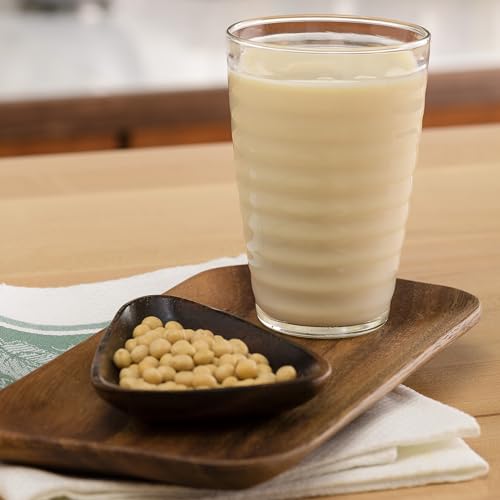Soy milk curdling in coffee can be a frustrating experience for those seeking a smooth and creamy beverage. But fear not, for here are some tips and alternatives to prevent this unwanted reaction.
The key to understanding curdling is that hot coffee accelerates the lactic acid production by bacteria in milk, which causes proteins to clump together. Lowering the coffee’s acidity can help prevent curdling, as can pouring soy milk slowly while stirring gently. If all else fails, non-dairy milk options like oat milk or barista editions can save the day.
Let’s find out more….
Understanding the Science Behind Curdling
The process of curdling occurs when the proteins in soy milk clump together due to the production of lactic acid by bacteria in the milk, which is accelerated by higher temperatures and the natural acidity of coffee.
When the temperature of the coffee is elevated, the curdling process happens more rapidly. Coffee itself is naturally acidic, which further promotes curdling. Understanding the science behind curdling is essential in preventing it. Lowering the acidity of coffee can help prevent curdling, and different coffee beans and brewing methods can influence acidity levels.
African coffees tend to be more acidic, while South and Central American coffees are less acidic.
Cold brew coffee is significantly less acidic than hot-brewing methods. By adjusting the temperature and acidity of the coffee, one can reduce the chances of soy milk curdling and enjoy a smooth cup of coffee.
Factors Influencing Soy Milk Curdling in Coffee
Factors such as temperature and acidity can influence the curdling of soy milk in coffee.
The curdling process occurs when proteins in the soy milk clump together due to the presence of lactic acid, which is produced by bacteria in the milk. Higher temperatures and acidic environments accelerate this process, making hot coffee more prone to curdling.
To prevent curdling, one can lower the acidity of the coffee by choosing less acidic beans or using cold brew methods.
Alternatively, slowly adding the soy milk to hot coffee while stirring gently can help prevent curdling.
If all else fails, alternative non-dairy milk options like oat milk or barista editions specifically designed for coffee can be used. Experimentation with different options is key to finding the perfect non-dairy milk that doesn’t curdle in coffee.
Choosing Low Acid Coffee Options
Opting for a coffee with a lower acidity level can help reduce the chances of curdling soy milk. When choosing a low acid coffee option, consider the following:
- Look for coffee beans from South or Central America, such as Colombian, Nicaraguan, or Brazilian beans. These tend to be less acidic compared to African coffees.
- Cold brew coffee is significantly less acidic than hot brewing methods. So, if curdling is a concern, try opting for cold brew instead.
- Barista editions of non-dairy milk, such as oat milk, are designed specifically for use in coffee and are less likely to curdle.
Temperature Techniques for Curdling Prevention
Pouring the hot coffee slowly into the soy milk while stirring gently can help prevent curdling. This technique combines temperature control and the gradual introduction of the milk to minimize curdling. However, it is important to note that this method is not foolproof and curdling can still occur. Patience and careful pouring are key.
To further understand the factors that affect curdling prevention, consider the following table:
| Factors Affecting Curdling Prevention | |
|---|---|
| Lowering coffee’s acidity | Helps prevent curdling |
| Different coffee beans and brewing methods | Influence acidity |
| African coffees tend to be more acidic | South and Central American coffees are less acidic |
| Cold brew coffee is less acidic than hot brewing methods | Decreases curdling rate |
| Changing the brewing method or origin of the coffee | Can affect curdling |
The Art of Pouring Soy Milk Into Coffee
Adding soy milk to coffee requires a delicate touch to ensure a smooth and creamy texture. To prevent curdling and achieve the perfect blend, follow these tips:
- Pour the soy milk slowly into the hot coffee while stirring gently.
- Incrementally add the coffee to the milk, rather than pouring the milk into the coffee all at once.
- Gradually increase the temperature of the milk and slightly cool the coffee to reduce the rate of curdling.
These techniques require patience and careful pouring, but they can help prevent curdling. However, if curdling still occurs, consider trying alternative non-dairy milk options such as oat milk, which is less prone to curdling. Barista editions of non-dairy milk are also specially designed for use in coffee and are less likely to curdle. Experimenting with different non-dairy milk options can help you find one that achieves the desired creamy texture without any curdling.
Patience and Precision: Curdling Prevention Methods
Achieving a smooth and creamy texture in coffee requires patience and precision when it comes to preventing curdling. To prevent curdling, it is important to consider the factors that contribute to it, such as temperature and acidity. Curdling occurs when the proteins in soy milk clump together, and this process is accelerated by hot temperatures and the natural acidity of coffee. Lowering the acidity of coffee can help prevent curdling, and different coffee beans and brewing methods can influence acidity levels. Additionally, slowly adding soy milk to hot coffee while stirring gently can help prevent curdling. If curdling still occurs, experimenting with alternative non-dairy milk options, such as oat milk or barista editions designed for coffee, may be a solution. With patience and careful attention to detail, a smooth and creamy cup of coffee can be enjoyed without the worry of curdling.
Exploring Non-Dairy Milk Alternatives
After exploring the techniques for preventing soy milk curdling in coffee, it’s worth considering alternative non-dairy milk options. For those who continue to experience curdling issues, experimenting with different non-dairy milk varieties may offer a solution. Here are a few options to consider:
- Oat milk: Oat milk is known to be less prone to curdling than soy milk. Its creamy texture and mild flavor make it a popular choice among coffee lovers.
- Barista editions: Barista editions of non-dairy milk are specially formulated for use in coffee. These varieties are designed to withstand high temperatures and acidity, reducing the likelihood of curdling.
- Other non-dairy milk options: There is a wide range of non-dairy milk alternatives available today, including almond, coconut, and rice milk. Experimenting with these options may lead to a non-dairy milk that doesn’t curdle in coffee.
Oat Milk: A Curdling Resistant Option
Oat milk provides a curdling resistant option for those seeking a non-dairy alternative in their coffee. Unlike soy milk, which can curdle when mixed with hot coffee due to its protein content, oat milk is less prone to curdling. This makes it a reliable choice for those who want to enjoy their coffee without any curdling issues. Oat milk has a creamy texture and a mild, slightly sweet taste that complements the flavor of coffee. It is also versatile and can be used in various coffee-based drinks, such as lattes and cappuccinos. Additionally, many brands offer barista editions of oat milk, which are specifically formulated to withstand high temperatures and prevent curdling. So, whether you enjoy a hot cup of joe or a refreshing iced coffee, oat milk is a fantastic option to consider for a smooth and curdling-free experience.
Barista Editions: Non-Dairy Milk for Coffee Lovers
After discussing the oat milk option as a curdling-resistant alternative, let’s explore another option for coffee lovers: barista editions of non-dairy milk. These specially formulated milks are designed to withstand the heat and acidity of coffee without curdling. Here are some key points to consider:
- Barista editions of non-dairy milk are specifically made for use in coffee, ensuring a smooth and creamy texture.
- These milks are often fortified with additional proteins and oils to enhance their ability to froth and blend well with coffee.
- Barista editions are available in various types, such as soy, almond, oat, and coconut, providing a wide range of options to suit different preferences.













